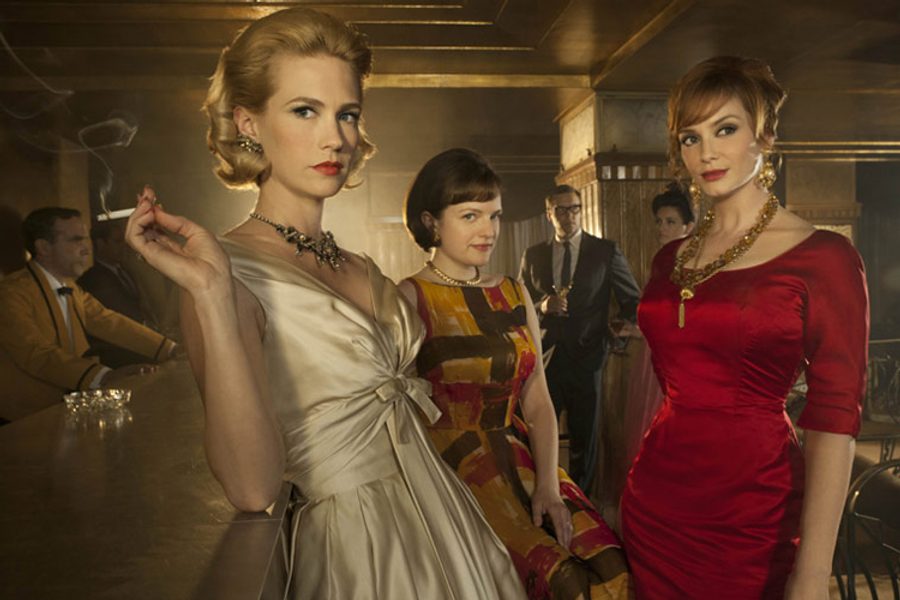The End of Mad Men and the Rise of Women
None of the women of Mad Men end up where they wanted to be. But they struggled, and they did rise.
Jude Ellison Sady Doyle

[SPOILER ALERT: This recap contains major spoilers for the series finale.]
Mad Men as a series is built around denying us traditional narrative satisfaction. There are no blinding revelations, no drastic changes, no big, heroic moments. Its characters just live.
But how does a series that’s entirely about the little moments in life, and the slow accumulation of time, come to a satisfying end? Life doesn’t end with a big, satisfying moral wrap-up for the audience. TV shows do. I feel unsatisfied by Mad Men’s wrap-ups for its female characters, while also knowing that much of it is perfectly in keeping with what was great about the series. The characters I rooted for don’t get big pay-offs. They get lives, defined by the choices they’ve made — lives that, with one or two big exceptions, will go on.
Mad Men was perhaps the most satisfying feminist drama on television— beautifully done, maddeningly realistic and only occasionally preachy. It became clear, quickly, that the male characters were not the point of the show. Don the self-destructive shyster, Roger the 20th-century Caligula, Pete the blue-blood weasel: Sure, those guys were interesting. Frequently entertaining. Pete alone was a non-stop whirl of weird dances and useful .GIFs.
But the female characters had real things at stake. Every major female character — Peggy, Joan, Betty — started off in a scenario wherein success or liberation felt impossible. What we knew, and they didn’t, was that the playing field was about to change; that the ‘60s would see a radical re-envisioning of how sex, gender (and race, not that Mad Men was ever brilliant on that front) were treated. The endlessly analyzed credits showed a man falling. What feminist viewers believed was that the women would rise.
Well, it’s over now. And nobody blew up the patriarchy. Instead of, as Joan put it, “burning this place down,” they each get incremental wins, which are invariably the precise opposite of what they thought they wanted. They all wind up about two inches away from their personal starting lines and facing in the wrong direction. But we know them better now, and we can appreciate the work they put in to gain even a few inches of territory in a hostile world.
So let’s try, for just one moment, to remember who we thought these characters were: Peggy, the loser; Joan, the sexpot; Betty, the victim.
Peggy is the character it’s been easiest to root for, in part because she became an avatar for the career ambitions and feminist politics of current-day viewers. Watching her do her strut down the hallway of McCann Erickson — sunglasses on, octopus porn under her arm, giving no fucks whatsoever — feels like watching ourselves. A cooler, smarter self, maybe. But we can idealize and emulate Peggy now, the way male viewers often used to idealize Don or Roger.
Yet when this show first aired, people often disliked Peggy. I knew several viewers (mostly men, granted) who considered her boring, or “mousy,” or self-righteous; in the face of the glorious, shameless decadence of the other characters, Peggy was the sourpuss who yelled about finding vomit in the office trash can after a party. And, granted, it was hard to find a character’s romantic plot line compelling when it mostly revolved around awkward, regrettable couch sex with Pete Campbell. She wasn’t sexy or fun. She was just smart. It didn’t much endear her to viewers.
Yet we know Peggy now. We know that the limited tolerance for bullshit she exhibited when yelling about puke-trashcans (“I’m from Bay Ridge; people have manners”) would also make her tough enough to succeed in a male-dominated profession. She’s earned our respect. I don’t think it’s a stretch to say that most viewers expected she would earn that respect from the world: That she would become the creative director of Sterling Cooper, the Don Draper for the next generation, the show’s big success story.
Which brings us to Joan. Poor, poor Joan, who (and now it’s time for my own embarrassing admission) was the character I “hated” back in Season 1. Joan was Peggy’s adversary in those days: She was the woman who drank the patriarchal Kool-Aid, and who imbibed of it so deeply that she not only structured her own behavior around appealing to men (husband-hunting, boss-romancing; at one point, this woman bent over and presented herself like a baboon simply because she knew men were watching her through two-way glass) but would punish and mock other women for failing to do the same. She told Peggy to lose weight if she wanted to keep her job. She turned up her nose at Peggy’s desire to be a copywriter. When Peggy reported being sexually harassed, Joan told her to suck it up, because she wasn’t pretty, and should be grateful for the attention.
I bring all this up because Joan, by this point, has been subjected to more sexual harassment and cruelty than any other character on the show. She is a rape survivor. She was married to her rapist. She was made to sleep with the loathsome Herb from Jaguar to get a partnership. At one point, it seemed as if Joan’s suffering was meant to “humanize” her; soon enough, it started to seem like a way to punish her, as if the character had to be put through an unending gauntlet of humiliation and exploitation in order to pay for the crime of being sexually attractive.
Last week, it seemed as if her final pay-off would be her biggest humiliation, with her transition to McCann-Erickson more or less making her partnership irrelevant, and the levels of sexual harassment she experienced spiking off the charts. Once again, Joan was expected to sleep with her male colleagues to get by. This time, she invoked the name of Betty Friedan and quit.
But here’s the thing: Did you really expect Joan, of all people, to be the woman who threatened to call NOW into the office? Did you expect Peggy to end the series dreamily wrapped in the arms of her one true love — who happens to be the show’s primary male sex object? (Sorry, Jon Hamm. You’re a very handsome guy and all, but in the world of straight women watching Mad Men, “Stan Rizzo grew a beard” was the sexual equivalent of the goddamn moon landing.)
The characters’ payoffs are the exact inverse of what they thought they wanted. Joan, the woman who started out with the goal of landing a rich husband, winds up having to kick yet another loser boyfriend to the curb (good news—this loser’s on cocaine!) in order to start her own business. Peggy, the woman we’ve been rooting for as a creative force and a professional, gets a perfect boyfriend and the promise that she might “be a creative director by 1980.”
As a way to show how much each woman has grown over the past decade, it’s brilliant. As realism, it’s brilliant: The odds that Joan could find a man who was comfortable dating a single-mother-slash-CEO in 1971 were always going to be low, and so were the odds of Peggy somehow shooting from mid-level copywriter to world’s greatest creative director within the space of an episode.
Yet, as a fan, it’s hard not to feel cheated. Can Joan only embrace her competence by giving up her sex life? Does Peggy’s rom-com ending, sweet though it might be, erase the fact that she’s going to be stuck working in a sexist office, under people who know less about the job than she does, for at least 10 more years?
The big clue here — and the reason I’m finding my peace with both of those endings — is Betty Hofstadt Draper Francis. I have a huge, admittedly strange soft spot for Betty: raised to be as decorative and useless as a houseplant, trapped in a “perfect” marriage with a man who barely noticed her, obliged to have children that she had no idea how to raise and whom she seemed to despise, Betty was warped and strange and awful because she’d never been taught how to be anything else. She was exactly what a woman was supposed to be, and it was horrifying. I cared about her, not because she was a particularly good or kind or intelligent woman, but because she deserved the chance to realize how good, kind and intelligent she could be.
Betty’s ending was as beautiful as I could imagine for her. It was also the cruelest ending Mad Men gave to any of its major characters.
Betty learned to be a grown-up — or, at least, an 18-year-old — by going back to college and studying to be a psychologist. And she did this just in time to die. As we leave her, she has stage four lung cancer and six months to live. Her classes are useless; her ambitions are useless. Her attempt to be a better person is useless. Her life has been wasted, and now it’s over, and she will die as the same Betty she’s always been — the Betty who never actually lived at all.
She learns this. She accepts this. And then she goes back to school.
As far as I’m concerned. Mad Men could have ended on the shot of Betty — warped, strange, sad Betty, the show’s biggest casualty of the pre-feminist era — returning to her classes, gasping for breath as she climbs that impossibly high set of stairs. I don’t really care if Don Draper found inner peace or just an idea for a Coke ad. I don’t need to know what Pete Campbell did with his office cactus. It’s all there, in that shot: The man falls. The woman rises. That was the story, and this is how it ends.
The stairs don’t go anywhere for Betty, it turns out. She never gets to the top. She never gets what she wants — that better life, that realized, liberated person she ought to be. We never find out if Peggy gets the creative directorship; we never know if Joan gets a life where she can be valued as both a sexual person and as a competent professional, without one having to cancel the other out. Their stairs don’t go that far up, either. Sexism shifted in the ‘60s, but it didn’t shatter. If you’ll recall, it’s still around — and is still going strong, which is why many women watched Mad Men.
But they keep climbing. Betty, Joan, Peggy: We leave them climbing. Because that’s what you do. Because you are defined not by how far you get, but by the fact that you fought to get somewhere. And if even Betty Draper can learn that much, I think Joan and Peggy (and you and I) can figure it out.
These stories weren’t important because of where those women wound up. They didn’t change the culture or matter so deeply to so many people because we were guaranteed a good, kind ending or a reward for their struggles. They were important because of the struggles. They mattered because they showed us women in the act of rising.
Jude Ellison Sady Doyle is an In These Times contributing writer. They are the author of Trainwreck: The Women We Love to Hate, Mock, and Fear… and Why (Melville House, 2016) and was the founder of the blog Tiger Beatdown. You can follow them on Twitter at @sadydoyle.








